浅析汉英翻译中的中国式英语
- 格式:doc
- 大小:99.50 KB
- 文档页数:19
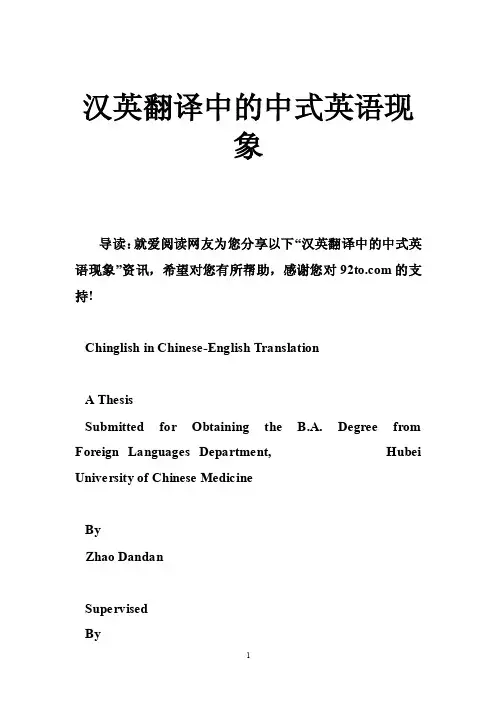
汉英翻译中的中式英语现象导读:就爱阅读网友为您分享以下“汉英翻译中的中式英语现象”资讯,希望对您有所帮助,感谢您对的支持!Chinglish in Chinese-English TranslationA ThesisSubmitted for Obtaining the B.A. Degree from Foreign Languages Department, Hubei University of Chinese MedicineByZhao DandanSupervisedByLecturer Cheng AiliMay 26, 2011SignatureThe thesis of Chinglish in Chinese-English Translation by Zhao Dandan was reviewed and approved by Lecturer Cheng Aili on May26, 2011.Supervisor :________________( Signature) AcknowledgementsThis thesis was completed on February 26, 2011, and many people have helped with it. Here I would particularly like to thank my respectable supervisor, Lecturer Cheng Aili, for the valuable advice that she has given me in the writing of this thesis. In addition to what she has taught in her spare time on how to prepare and write the thesis, I also want toacknowledge all the teachers in Foreign Languages Department of Hubei University of Chinese Medicine who have provided me with rich information and great encouragement and their efforts to offer me the form and rules. Besides, my roommates should be acknowledged too for their kind and generous help.Abstract: With the development of the economic globalization, English has become an international language used in many countries and fields in the world, especially in international conferences, documents of corporations and internet. In China, with the further development of the reform and opening-up policy and the increasing frequent communication with foreign countries, English has gained more and more attention as a bond to exchange with other countries. As a great many Chinese people are learning English, there appears an intricate problem, chinglish, a language between Chinese and English, which has become a common problem perplexing English learners in China ,so it is essential to overcome this problem. The whole thesis is to discuss chinglish in C-E translation and is developed fromtranslational perspective in three aspects: the influence of different culture between China and western countries on C-E translation, manifestations of chinglish and the countermeasures of this problem.Key Words: chinglish translation reason manifestation countermeasure摘要:随着经济全球化的发展,在许多国家,英语作为一种国际通用的语言被使用在世界的各个领域,尤其是在国际会议、公司的重要文件以及网络等方面。
![[浅析“中式英语”翻译中汉语思维的影响]浅析中式英语](https://uimg.taocdn.com/c92f15fa4431b90d6d85c724.webp)
[浅析“中式英语”翻译中汉语思维的影响]浅析中式英语“中式英语”是中国人在学习和使用英语时,受汉语语言文化影响而产生的中介语变异体,是一种不可避免的过渡现象。
它是在已经有了第一语言用于思维,第二语言的学习者很难开始用第二语言进行思维。
要学会用第二语言进行思维,需要以对该种语言相当程度的掌握为前提。
不可能一开始就学会。
一汉语思维导致“中式英语”翻译的形成语言是思维的主要载体,也是思维的主要表现形式,思维方式制约着句子结构。
汉语和英语在思维方式上截然不同。
尽管我们希望英语学习者能达到用英语思维来思考,不用汉语思维直接进行交际或写作,但是,由于想进行的交际内容的广泛和以掌握的英语知识的贫乏,初学者在进行交际或写作时,仍然会很自然的先用汉语思维思考,再用英语将思维结果表达出来,从而形成中式英语。
如:①He kicked the ball with his foot,(He kicked the ball,他一脚把球踢开了。
)②Bob hit my face,(Bob hit me in my face,鲍勃打了我的脸。
)以上二个句子从语法结构上来看都是正确的,但均不符合英语习惯,就是因为英语国家的人在思维方式上与我们是截然不同的。
如例句1,英语国家的人认为“踢”(kick)这一动作本来就只能由脚来完成,不必再加“with his foot”,因此不能延用汉语的“一脚踢开”的习惯。
在例句2中,汉语思维强调“打了脸”,而英语思维习惯则需表达为“打了我”,脸则只是打在身体上的某个地方。
二汉语主体思维的倾向差异使得“中式英语”翻译更为明显英汉两种思维方式的差异在语言表达上其明显的标志之一就是描述实物和阐述事例的过程中,特别是当涉及到行为主体时,汉语习惯于用人或表示生物的词做主语(或潜在的主语),而英语则常用非生物名词做主语如:The thought of resuming filled her with fear,她一想到要返回去,心里就害怕。
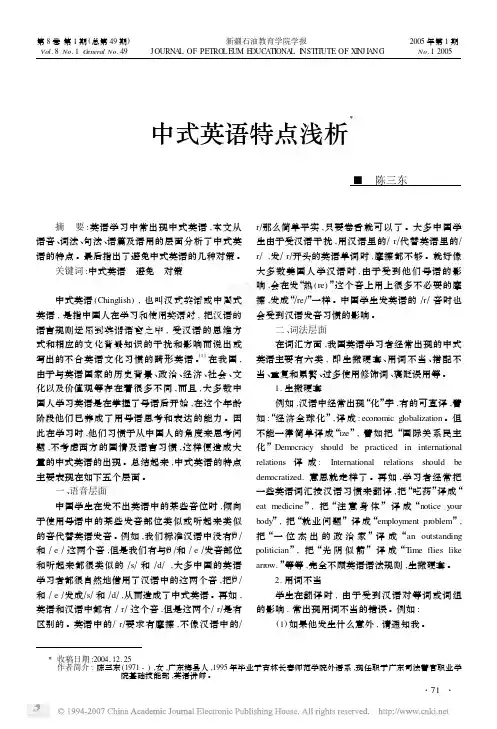
中式英语特点浅析Ξ■ 陈三东 摘 要:英语学习中常出现中式英语,本文从语音、词法、句法、语篇及语用的层面分析了中式英语的特点。
最后指出了避免中式英语的几种对策。
关键词:中式英语 避免 对策中式英语(Chinglish ),也叫汉式英语或中国式英语,是指中国人在学习和使用英语时,把汉语的语言规则运用到英语语言之中,受汉语的思维方式和相应的文化背景知识的干扰和影响而说出或。
[1]在我国,由于与英语国家的历史背景、政治、经济、社会、文化以及价值观等存在着很多不同,而且,大多数中国人学习英语是在掌握了母语后开始,在这个年龄阶段他们已养成了用母语思考和表达的能力。
因此在学习时,他们习惯于从中国人的角度来思考问题,不考虑西方的国情及语言习惯,这样便造成大量的中式英语的出现。
总结起来,中式英语的特点主要表现在如下五个层面。
一、语音层面中国学生在发不出英语中的某些音位时,倾向于使用母语中的某些发音部位类似或听起来类似的音代替英语发音。
例如,我们标准汉语中没有ΠθΠ和Πe Π这两个音,但是我们有与ΠθΠ和Πe Π发音部位和听起来都很类似的Πs Π和Πd Π,大多中国的英语学习者都很自然地借用了汉语中的这两个音,把ΠθΠ和Πe Π发成Πs Π和Πd Π,从而造成了中式英语。
再如,英语和汉语中都有Πr Π这个音,但是这两个Πr Π是有区别的。
英语中的Πr Π要求有摩擦,不像汉语中的Πr Π那么简单平实,只要卷舌就可以了。
大多中国学生由于受汉语干扰,用汉语里的Πr Π代替英语里的Πr Π,发Πr Π开头的英语单词时,摩擦都不够。
就好像大多数美国人学汉语时,由于受到他们母语的影响,会在发“热(re )”这个音上用上很多不必要的摩擦,发成“Πre Π”一样。
中国学生发英语的Πr Π音时也会受到汉语发音习惯的影响。
二、词法层面在词汇方面,我国英语学习者经常出现的中式英语主要有六类,即生搬硬套、用词不当、搭配不当、重复和累赘、过多使用修饰词、褒贬误用等。
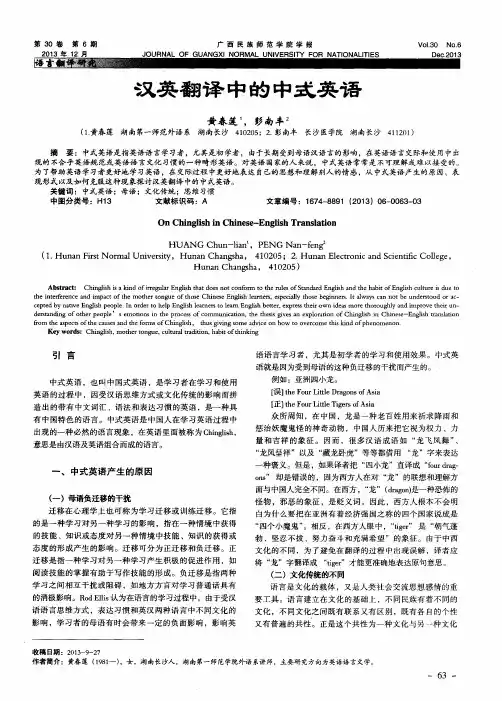
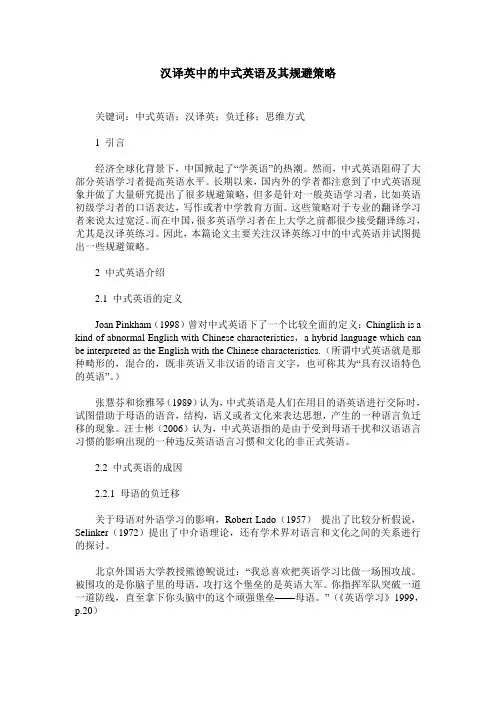
汉译英中的中式英语及其规避策略关键词:中式英语;汉译英;负迁移;思维方式1 引言经济全球化背景下,中国掀起了“学英语”的热潮。
然而,中式英语阻碍了大部分英语学习者提高英语水平。
长期以来,国内外的学者都注意到了中式英语现象并做了大量研究提出了很多规避策略,但多是针对一般英语学习者,比如英语初级学习者的口语表达,写作或者中学教育方面。
这些策略对于专业的翻译学习者来说太过宽泛。
而在中国,很多英语学习者在上大学之前都很少接受翻译练习,尤其是汉译英练习。
因此,本篇论文主要关注汉译英练习中的中式英语并试图提出一些规避策略。
2 中式英语介绍2.1 中式英语的定义Joan Pinkham(1998)曾对中式英语下了一个比较全面的定义:Chinglish is a kind of abnormal English with Chinese characteristics,a hybrid language which can be interpreted as the English with the Chinese characteristics.(所谓中式英语就是那种畸形的,混合的,既非英语又非汉语的语言文字,也可称其为“具有汉语特色的英语”。
)张慧芬和徐雅琴(1989)认为,中式英语是人们在用目的语英语进行交际时,试图借助于母语的语音,结构,语义或者文化来表达思想,产生的一种语言负迁移的现象。
汪士彬(2006)认为,中式英语指的是由于受到母语干扰和汉语语言习惯的影响出现的一种违反英语语言习惯和文化的非正式英语。
2.2 中式英语的成因2.2.1 母语的负迁移关于母语对外语学习的影响,Robert Lado(1957)提出了比较分析假说,Selinker(1972)提出了中介语理论,还有学术界对语言和文化之间的关系进行的探讨。
北京外国语大学教授熊德鲵说过:“我总喜欢把英语学习比做一场围攻战。
被围攻的是你脑子里的母语,攻打这个堡垒的是英语大军。

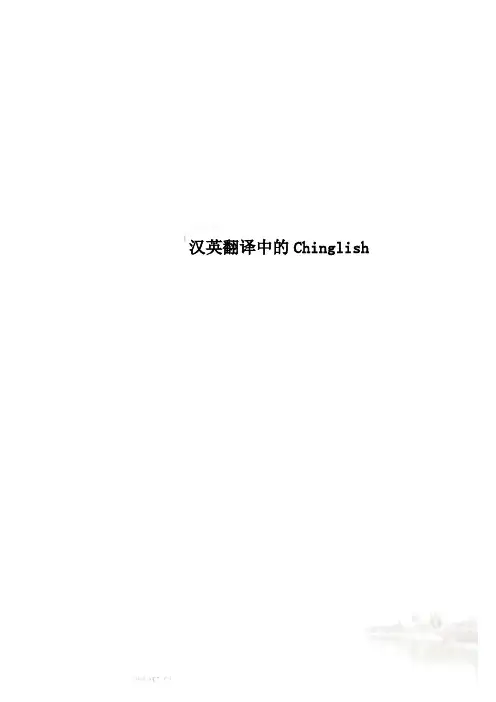
汉英翻译中的Chinglish严复的"信、达、雅"三个字精辟地概括了翻译的标准。
这个标准要求译文既能忠实准确地表达原意,又能通顺流畅、文辞优美、可读性强。
但在实践中达到这个标准,却不是一件容易的事。
汉英翻译中有两种倾向:一种是一味追求译文流畅、文辞优美,忽略乃至偏离了原意;另一种是过于拘泥原文字句,机械地从字面上"对号入座",译文不顺而且难懂。
这两种倾向都不符合"信、达、雅"标准。
在外事翻译中,后一种倾向更为常见。
造成这一问题既有主观原因,如怕译文出政治差错,认为直译比较保险,因而不敢越雷池一步;另外也有客观的因素,政治、外交翻译政策性强,不仅要求内容准确、文字严密,而且时间性强,给翻译的时间有限,译者经常处于完成任务的匆忙之中,"该出手时就出手",难以从容地进行推敲润色,因而译文常常迁就中文,顾不得精益求精。
我在四十年的翻译工作中,在限定时间内出手的译文常常留下一些永久的遗憾。
当然,我们的翻译工作一直在进步、在发展,尤其是改革开放以来的20年时间里,解决了大量出现的新问题、新词汇、新提法,在外交和对外宣传工作中发挥了巨大作用。
但也不容忽视我们工作中存在的问题,特别是译文质量方面的问题。
提高译文质量需要多方面的努力,我感到今后最需要也是最难解决的问题之一,就是如何克服"中式英文",即"Chinglish"问题。
"Chinglish"是我上面所说后一种倾向的一个表现,它的存在导致某些译文生硬晦涩,使讲英语的读者敬而远之,影响了对外宣传的效果。
还不能不引起我们的注意。
对"Chinglish",我们需要做一些理论上的探讨,但我认为更主要的是如何从实践中去求得解决。
解决了这个问题,就可能使我们的译文更完美,更接近于"信、达、雅"这个标准。
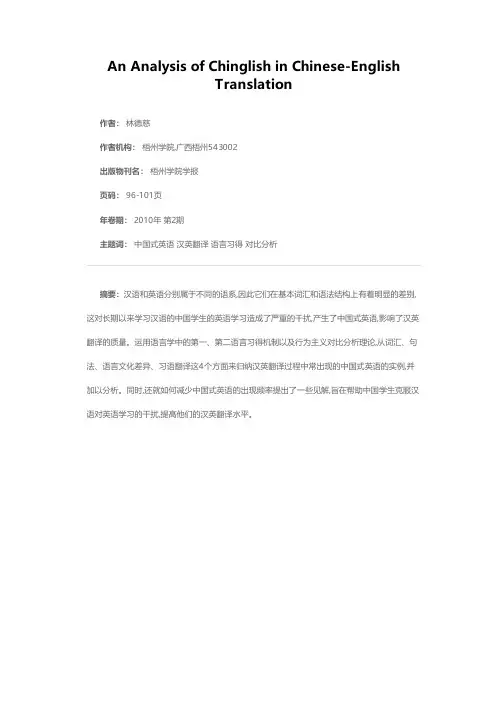
An Analysis of Chinglish in Chinese-English
Translation
作者: 林德慈
作者机构: 梧州学院,广西梧州543002
出版物刊名: 梧州学院学报
页码: 96-101页
年卷期: 2010年 第2期
主题词: 中国式英语 汉英翻译 语言习得 对比分析
摘要:汉语和英语分别属于不同的语系,因此它们在基本词汇和语法结构上有着明显的差别,这对长期以来学习汉语的中国学生的英语学习造成了严重的干扰,产生了中国式英语,影响了汉英翻译的质量。
运用语言学中的第一、第二语言习得机制以及行为主义对比分析理论,从词汇、句法、语言文化差异、习语翻译这4个方面来归纳汉英翻译过程中常出现的中国式英语的实例,并加以分析。
同时,还就如何减少中国式英语的出现频率提出了一些见解,旨在帮助中国学生克服汉语对英语学习的干扰,提高他们的汉英翻译水平。
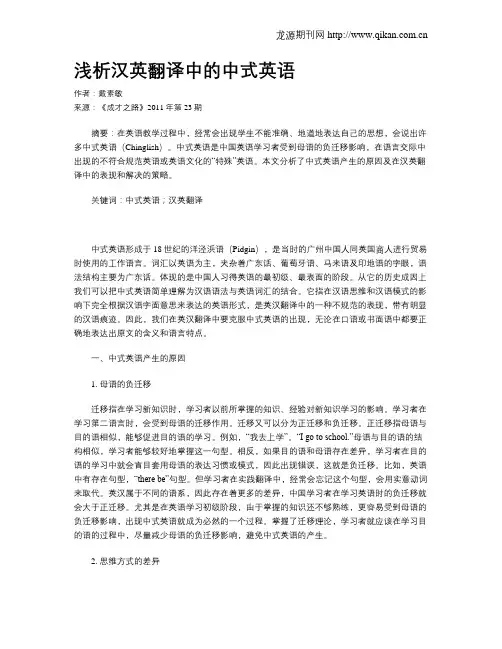
浅析汉英翻译中的中式英语作者:戴素敏来源:《成才之路》2011年第23期摘要:在英语教学过程中,经常会出现学生不能准确、地道地表达自己的思想,会说出许多中式英语(Chinglish)。
中式英语是中国英语学习者受到母语的负迁移影响,在语言交际中出现的不符合规范英语或英语文化的“特殊”英语。
本文分析了中式英语产生的原因及在汉英翻译中的表现和解决的策略。
关键词:中式英语;汉英翻译中式英语形成于18世纪的洋泾浜语(Pidgin),是当时的广州中国人同英国商人进行贸易时使用的工作语言。
词汇以英语为主,夹杂着广东话、葡萄牙语、马来语及印地语的字眼,语法结构主要为广东话。
体现的是中国人习得英语的最初级、最表面的阶段。
从它的历史成因上我们可以把中式英语简单理解为汉语语法与英语词汇的结合。
它指在汉语思维和汉语模式的影响下完全根据汉语字面意思来表达的英语形式,是英汉翻译中的一种不规范的表现,带有明显的汉语痕迹。
因此,我们在英汉翻译中要克服中式英语的出现,无论在口语或书面语中都要正确地表达出原文的含义和语言特点。
一、中式英语产生的原因1. 母语的负迁移迁移指在学习新知识时,学习者以前所掌握的知识、经验对新知识学习的影响。
学习者在学习第二语言时,会受到母语的迁移作用。
迁移又可以分为正迁移和负迁移。
正迁移指母语与目的语相似,能够促进目的语的学习。
例如,“我去上学”。
“I go to school.”母语与目的语的结构相似,学习者能够较好地掌握这一句型。
相反,如果目的语和母语存在差异,学习者在目的语的学习中就会盲目套用母语的表达习惯或模式,因此出现错误,这就是负迁移。
比如,英语中有存在句型,“there be”句型。
但学习者在实践翻译中,经常会忘记这个句型,会用实意动词来取代。
英汉属于不同的语系,因此存在着更多的差异,中国学习者在学习英语时的负迁移就会大于正迁移。
尤其是在英语学习初级阶段,由于掌握的知识还不够熟练,更容易受到母语的负迁移影响,出现中式英语就成为必然的一个过程。

- 220-校园英语 / 翻译研究原文意思,让学习者更加轻松深刻理解其内容。
2.专业表达力求精确,再现课程特征。
字幕翻译是归属于文学翻译这一大树干的一小分支,在翻译时也要遵循文学翻译的基本原则:信、达、雅。
根据当前网络公开课的特点,公开课字幕翻译主要是传达新知识,至此在其字幕翻译上,尤其要注重的还是“信”。
《哲学:死亡》它是属于哲学领域的一门课程,专业知识非常多而且不容易理解,虽然Shelly kagan 的讲课非常生动风趣,讲授方式深入浅出,但是还是不能够有效地对专业术语进行贴切的表达。
在网络公开课字幕翻译过程中把握译意的准确性非常关键。
譬如在公开课《哲学:死亡》的教学内容中,涉及到一个单词:physicalism ,它的通用表达意思是物理主义。
那到底把“physicalism ”直译成“物理主义”符不符合原语内容?通过哲学学者的解释,译者最终确定译为物理主义。
这说明在公开课的字幕翻译过程中,要注重强调“信”,对原语进行字幕翻译时,特别是专业性强的源语,字幕翻译要结合原语内容进行翻译,这也是名校公开课在传授新知识时的主观诉求。
3.切合学者风格,再现幽默。
网络名校公开课受到众多学习者的喜爱和追捧,这与讲课教授的人格魅力和教学方式是分不开的。
《死亡》课上喜欢坐在讲座上,盘着腿,非常书生气质的小老头Shelly kagan ,《公正》课上喜欢抛出问题和询问学生的名字,可以记住每个回答问题学生的看法的 MichaelJ.Sandel ,又或是《幸福课》上那个因为名字里缺一个字母“L ”,因此个头不够“TALL ”的TalBen Shahar ,这些课程教授的性格不管是外放型的还是内敛型的,教授们在授课过程中经常会智慧地将幽默元素融入课程教学内容中。
因此,译者们在进行翻译的过程中要根据语言的特征适当的添加幽默元素在其中,而这也是需要策略的。
4. leaning over the bridge is a very fat man.靠着桥站着的是个超级大胖子。
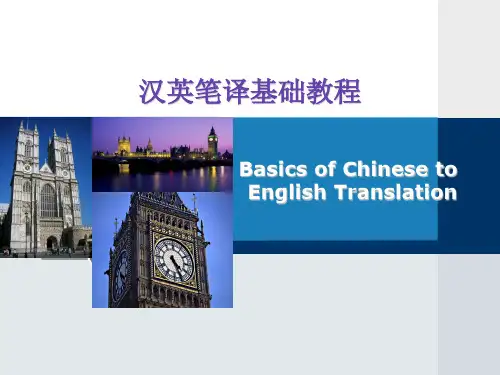
浅析汉英翻译中的中式英语【3篇】(经典版)编制人:__________________审核人:__________________审批人:__________________编制单位:__________________编制时间:____年____月____日序言下载提示:该文档是本店铺精心编制而成的,希望大家下载后,能够帮助大家解决实际问题。
文档下载后可定制修改,请根据实际需要进行调整和使用,谢谢!并且,本店铺为大家提供各种类型的经典范文,如工作资料、求职资料、报告大全、方案大全、合同协议、条据文书、教学资料、教案设计、作文大全、其他范文等等,想了解不同范文格式和写法,敬请关注!Download tips: This document is carefully compiled by this editor. I hope that after you download it, it can help you solve practical problems. The document can be customized and modified after downloading, please adjust and use it according to actual needs, thank you!In addition, this shop provides you with various types of classic model essays, such as work materials, job search materials, report encyclopedia, scheme encyclopedia, contract agreements, documents, teaching materials, teaching plan design, composition encyclopedia, other model essays, etc. if you want to understand different model essay formats and writing methods, please pay attention!浅析汉英翻译中的中式英语【3篇】《论语》中君子和小人出现的频率极高,因此准确解读君子和小人的内在含义,对《论语》的整体翻译尤为重要。
浅谈英汉互译中的直译与意译Discussed shallowly the literal translation and the transliteration in English to Chinesetranslates mutually一、引言一直以来,无论是在我国还是在西方,直译与意译都是翻译讨论的中心话题。
“直译与意译之争,在我国自有翻译之时起就已存在”i。
次争论至少从公元前就已经开始。
到了十九世纪初,很多作家倾向与意译,即译其神韵而不是译字母;译意义而不是译词汇;译信息而不是译形式;译事实而不是译方式。
……“不过,这种争论是纯理论的,争论者并没有考虑到翻译的目的、读者的情况和文体类型等因素”ii。
也没有考虑到翻译都是有一定标准的。
那么首先就来了解一下英语翻译的标准。
二、阐述英语翻译的标准1、翻译标准的含义。
翻译标准是翻译实践的理论和衡量翻译文章的好坏的尺度。
2、严复提出的翻译标准“信达雅”。
所谓信是翻译的准确性能够忠实于作者的表达内容,达是翻译的通顺性,也就是说能够使用本土语言通顺的表达原文的主旨和思想,这也是翻译的一般要求,而雅是翻译的艺术性,比喻为原作的投胎转世,精神紫致和依然故我。
3、忠实和通顺。
忠实是译者把原作内容完整而准确的表达出来,不得有任何的篡改和歪曲。
通顺是指译文必须通俗易懂,符合语言规范。
忠实和通顺是相辅相成的。
他们对于原作内容,风格都有全面的照顾。
例如:I am up to my neck in your bullshit(你让我倒八辈子霉),没有把它译成“你把我害得好苦”,如果这样翻译就达不到前面的效果。
翻译是具备一定标准的,但在翻译中,我们得掌握翻译的技巧与方法来理解原文所表达的思想,用另一种语言再现原文的过程,这就谈到了翻译中直译与意译的表达阶段。
三、直译与意译的含义1、直译的含义。
直译就是在翻译文章语言条件许可时,在译文中既保持原文内容,又得保持原文形式。
A Brief Analysis of Chinglish inChinese-English TranslationInvestigatorHe CaixiaBeijing TV UniversitySubmitted on 12 May 2011In fulfillment of the course Practical Project Design浅析汉英翻译中的中国式英语研究者王小全中央广播电视大学提交2011年5月12日完成的课程设计实践项目AcknowledgmentI am mostly grateful to Professor Guide and MissZhang ,without whose support this project would not implemented.I am also grateful to my colleagues.Last but not the least , big thanks to my mother and father ,without whose support ,I would not have self-confidence to finish this project.AbstractTranslation is a well-structured transformation of both source language and target language; it is not a simple job of duplication. Chinese has its own character. When it is translated into English, it is necessary to follow the English rules. After all, Chinese and English are of fundamental difference. Not all vocabulary has equivalence in other language. As for the sentence structure, it is not the same as well. What‘s more, Chinese and English indicate different connotation because of the culture. It‘s difficult to make a compromise in the translation. Therefore, Chinglish easily occur. The manifestation includes: incorrect location of meaning, incorrect sentence structure and lacking of normalization. But generally, all these mistakes are interfered by mother tongue. Therefore, it‘s necessary to tackle the problem of Chinglish. To illustrate the problem of Chinglish, this paper will demonstrate a lot of example so as to evaluate the causes and suggestions of how to avoid or reduce it, with a purpose to bring translation nearer to a standard of faithfulness and smoothness.Key words: Chinglish;causes;culture;faithfulness;smoothness.浅析汉英翻译中的中国式英语【摘要】汉语和英语是两种不同的语言。
在汉英翻译中,由于英语学习者不注意对汉英两种语言的历史,文化,风俗习惯不同的学习和掌握,只习惯于英语的汉语解释,养成了简单的、机械的、僵化的学习方法和生搬硬套、逐字逐句的汉语式的英语表达方式.从而使得译文过于拘泥原文的字句,导致译文生硬,晦涩难懂,不符合英语习惯用法,让读者读后感觉译者只是在机械翻译,译文带有明显的汉语痕迹,这样的译文就是通常所谓的Chinglish(中式英语)Chinglish是影响译文质量的主要原因之一,这篇论文举例探讨Chinglish产生的原因、历史,表现形式及解决方法,从而避免汉语式英语,使汉英翻译达到忠实通顺。
【关键词】中国式英语;成因;忠实;通顺CONTENTSI. Introduction (1)1.1The Definition of Chinglish............ (1)1.2 History of Chinglish (1)1.3 Siginificance of avoiding it (1)II.Cases....................................................... .. (2)III. Causes of Chinglish (4)3.1 Cultural Differences (4)3.2 Usage of Voca bularies (5)3.3 Incorrect location of meaning (6)3.4 Difference between two language (6)3.5 Incorrect Sente nce Structure (7)IV. The Ways to Avoid Chinglish (8)4.1 Culture –Awareness (8)4.2 Three standards in Translation (8)4.3 Consulting Dictionary (11)4.4 Taking Context into Consideration (11)V. Conclusion (12)References (13)Acknowledgements (14)I IntroductionChinese and English are quite different. However, when native speaker of Chinese learn English, they tend to lose sight of the difference between the two. This is particularly the case when it comes to Chinese –English translation, because they have formed the habit of trying to write in English what they would in Chinese. As a result, Chinglish, an awkward mixture in which ideas conceived in Chinese are ungrammatically expressed in English, runs riot in their translation. The main cause of Chinglish is, of course, the linguistic interference. To remove the negative influence of the native tongue, therefore, remains a task of paramount important for students of English major in China.1.1The conception of Chinglish and root of its appearanceWhat is Chinglish?Chinglish is a combination of the words Chinese and English and refers to spoken or written English which is influenced by Chinese (Wikipedia). There are an estimated 300 to 500 million users and/or learners of English in the People's Republic of China. The term ―Chinglish‖is mostly used in popular contexts and may have pejorative or der ogatory connotation. The terms ―Chinese English‖ and ―China English" are also used, mostly in the academic community, to refer to Chinese varieties of English It is that we create English based on the habit of Chinese such as linguistic structure or even in the tradition and culture and the words‘ straight translation. It does not appear in the Chinese-English dictionary.1.2HistoryEnglish first arrived in China in the 1630s, when British traders arrived in South China. Chinese Pidgin English was spoken first in the areas of Macao and Guangzhou, later spreading north to Shanghai by the 1830s ―Y angjing Bang English‖in Chinese derives from the name of a former creek in Shanghai near the Bund where local workers communicated with English-speaking foreigners in pidgin (broken English) Chinese Pidgin English began to decline in the late 19th century as standard Englishbegan to be taught in the country's education system. English language teaching has been widespread throughout modern Chinese history-- it was made the country's main foreign language in 1982. At that time, the English learners usually heard the word ―Chinglish‖. In Qing dynasty(1840), the British invaders brought the English to China, many people wanted to learn English, but they didn‘t have enough time to do, so they just understood their physical meanings from the British conversations. And in the practical, they couldn‘t avoid the influence of the mother language-Chinese. So they just used fewer words to express the meanings, the Chinglish was invented by them.1.3The significance of avoiding itChinglish offers a humorous and insightful look at misuses of the English language in Chinese street signs, products, and advertising. (Oliver, 2007).A long-standing favorite of English speaking tourists and visitors, Chinglish is now quickly becoming a culture intergraded into Chinese. In preparation for the 2008 Olympic Games in Beijing, the Chinese government was determined to wipe out incorrect English usage of Chinglish and replaced it with Standard English. Among other examples, signs that previously read: "To take notice of safe: The slippery are very crafty" may read "Caution - slippery path". Other notable examples include: "Oil gate" (accelerator), "confirming distance" (keep space, distance verification), and so on.II.S ome funny Chinglish examples in Chinese-English translation 给你点颜色看看!!Give you some color to see see!!机房重地Engine room is serious place.走着瞧!Go and look!好好学习,天天向上good good study, day day up不三不四no three no four马马虎虎Horse horse tiger tiger你问我,我问谁?You ask me, I ask who?没钱没门No money no door咱俩谁跟谁阿we two who and who?怎么是你,怎么老是你How are you? How old are you?杀一警百kill one police hundred彼此彼此You me you me知之为知之,不知为不知...Know is know no know is no know来点音乐Come some music五讲四美三热爱5 talks, 4 beauties & 3 loves表妹Watch sister人山人海People mountain, people sea. (In English there is an expression ―sea of people‖, but not ―mountain of people.)我的电脑坏了My computer is broken. (My computer is down or my computer corrupted)All examples above are quite funny, but the English speakers get confused when reading them. If this kind of chinglsih cannot make any sense to native speakers, what‘s the purpose of translation? Translation is a well-structured transformation of both source language and target language; it is not a simple job of duplication.III Causes of ChinglishChinese has its own character. When it is translated into English, it is necessary to follow the English rules. After all, Chinese and English are of fundamental difference. Not all vocabulary has equivalence in other language. As for the sentence structure, it is not the same as well. What‘s more, Chinese and English indicate different connotation because of the culture. It‘s difficult to make a compromise in the translation. The refore, Chinglish easily occur. The manifestation includes: incorrect location of meaning, incorrect sentence structure and lacking of normalization. Incorrect location of meaning usually results from literal translation and unnecessary words. But generally, all these mistakes are interfered by mother tongue.3.1Cultural DifferenceLanguage has nationality that born with its nation and survive with it. Therefore special nations have their given language: there is no language without characteristic in the world as there is no race without characteristic. So, every language is not fully similar to each other, every race has its language. Take a same sugar for instance, Chinese call it ―红糖‖ just in order to distinguish with white sugar; English call it ―brown sugar‖ because its color is brown. Then why is there a different name between things of one? The answer is that they are effected by cultural gene that references human‘s way of thinking, the spoken way of habit, and traditional culture…etc. People who are surviving in different culture will have their given culture including the origin of histo ry, place of nationality, the development of society, and the style of politic and economy. So, in Chinese-English translation, Chinese will be influenced by their culture, language structure and the way of thinking. Chinese usually translate it in the way based on thehabit of Chinese such as linguistic structure or even in the tradition and culture and combine vocabularies‘ straight translation. Then we call it Chinglish.3.2Usage of vocabularies in Chinese—English translationMore and more vocabulary with the feature of Chinglish came out. After the reform, new vocabularies came out. They just exist in China. We did not find the corresponding words in English, so we just translate them word to word. So the Chinglish came out. (1) ―三讲‖ (讲学习,讲政治,讲正气)Chinglish: emphasize the need to study, to have political awareness and to be honest and upright.English: emphasize on three things: study, politics and integrity(2) 国际关系民主化Chinglish: International relations should be democratized.English: Democracy should be practiced in the international relations.3.2.1 Misuse of wordsIf Chinglish caused by inexact understanding of the meaning of word, as appears in the above sentences, is still understandable, misunderstanding of word brings about a kind of unbearable Chinglish. Let‘s see the following sentences.(1)When he reached his hand into his pocket for his wallet, he found it invisible. (missing; gone; lost)(2)As the price for the coat was too expensive,I can‘t buy it. (high)(3)Hi, Mary. Come along. I will first send you home in my car. (take)(4)I feel very painful in my left leg. (Great pain)3.2.2 Unnecessary repetitionsUnnecessary repetition also causes Chinglish The following repetition sentences in translation show clearly the negative influence of the native language.(1)English grammar is very difficult and few writers have avoided making mistakes in grammar. (Here ―grammar‖ should be replaced by ―it‖)(2)Our country is a great country with a long history and a large population.(Use ―Ours‖ instead of ―Our country‖ here)(3)Fish must stay in water. If they do not, they will die. (Use ―or‖ to compound the sentence.)(4)He gave many reasons for his failure, but the reason he gave did not convince people. (It should be ―but none of them was convinced‖).To get rid of Chinglish, students have to be made aware that Chinese is, for the most part, a logically compact language while English strictly compact in its structure.Unnecessary repetition is a deadly enemy to good written English. English verbs and nouns seldom repeat themselves in the same sentences, which are why conjunctions, pronouns and other substitution or introductory words are more frequently used in English than in Chinese.3.3 Incorrect location of meaningChinglish often appears in the form of redundancy which arises when students fail to understand the exact meaning of an English word. For example, Chinese students are inclined to say redundan cy ―a book desk ―or ―a writing desk‖ instead of simply ―desk‖. They do not know ―a dance‖ and ―a study‖ in English mean exactly ―a dance party‖ and ―a study room‖ in Chinese. Similarly, it is not uncommon to find the following redundant sentences in Chinese—English translation by Chinese students.(1) The old man lived by catching fish. (Fishing)(2) I can‘t afford to buy the color TV set for the time being. (afford)(3) Please hurry to climb up the mountain to help him. (hurry up)(4) My mother has gone to the shops to buy things. (shopping)3.4 Chinese a verb-redundant language while English a noun-oriented one.Another kind of Chinglish in the form of redundancy occurs when students are not taught that Chinese is a verb—redundant language while English a noun---oriented one. The following wordy sentences will serve to exemplify my point.(1) He ran out when it was raining hard. (into a heavy rain)(2) I looked at her and felt surprised. ( in surprise)(3)The meeting ended and everybody was bitter. (in bitterness)(4)We were shown in by two young men who wore black uniform.(in blackuniforms)Chinese students of English must be helped to discover that English prepositional phrases in many cases have the same semantic function as Chinese predicate verbsplus their objects. A good knowledge of this fact will provide Chinese students with a very useful means of becoming effective and idiomatic in their translation3.5 The incorrect sentence structureThe incorrect sentence structure also play an important role for Chinglish translation, as it can be seen from the following examples.3. 5.1 Bad arrangement in short phrasesThe words:来信写道Chinglish:The letter writesEnglish:The letter readsThe words:取得成就Chinglish:Make achievements scoreEnglish:attain achievementThe words:革命接班人Chinglish:Successors to the RevolutionaryEnglish:revolution successorsThe words:革命事业接班人Chinglish:Successors to the revolutionary causeEnglish:the Successors in the revolutionary cause3.5.2 Complete ignorance or negligence of the correct syntactic structure(1) The bankruptcy of his father has made him i mpossible to go abroad for further stud ies. (Here ―him‖ must be replace by ―it‖)(2) His English knowledge is very rich. (The correct sentence structure here should be ―His knowledge of English is very rich.)(3) The ―red guard‖ robbed all the books of the old professor.(The right collocation here has to be ―The ‗Red Guards‘ robbed the old professor of all his books.(4) I want the newest information. (Idiomatically speaking, the sentence should be ―I want the latest information,)To eliminate Chinglish of this sort, students should be keenly conscious of the differences in syntactic structures and word collocations between English and Chinese,and adapt the Chinese mind to English ways of expressing ideas.IV The Ways to Avoid ChinglishChingish is one of the major problems affecting the quality of Chinese-English sentences translation; we should make every effort to reduce and avoid it, and bring translation nearer to a standard of faithfulness and smoothness. Here are some suggestions.4.1 Culture –awarenessEvery language has its culture background, when we translate Chinese to English, we should first and foremost taking culture into consideration, to do this, we can add some necessary background wordsThree cobblers with their wits combined equal zhuge liang the mastermindDon‘t try to s how lu ban off your proficiency with the ax before lu Ban the master carpenter4.2 Three standards in Chinese —English translationTranslation standard is summed up in―信、达、雅‖which put forward by Yan Fu in the 19th century, which has always been a rule to the translators in translation. In this standard, ―信‖means ―faithful(to the original)‖. Obviously, ―faithful‖is the most important among the three, and it is the first responsibility to a translator. However, there are disparities between one language and another – disparities in the lexicology, in the linguistic structure or even in the tradition and culture.How to achieve the real faithfulness in a possible sense? A faithful translation in good formality with is not only the original context, but also the original form and style.However, as I have motioned before there are disparities between Chinese and English, not only in lexicology and in linguistic structure, but also in tradition and culture. To achieve such an effect we should do well in two aspects. On the one hand, faithful to the original does not mean to give an equivalent correspondence to each word literally. While doing this we should take these factors into consideration –idiomatic translation; the false faithfulness resulted from obligatory categories; different classifications in different cultures. On the other hand, faithful to the original also requires the translator to bring to the readers the feeling-tone of the original.To maintain that there is always an equivalent correspondence in one language that can match the one in another, which is a naive thought. And what a translator should do is to try every means to achieve the real faithfulness in a possible sense. That means a translation should be in good formality with the original context, form and style. What a translator should be faithful to is not the meaning of the odd words but that of the grammatical structure which is made up by these words. Take a short letter for example. ―昨奉大函,诵悉一是。